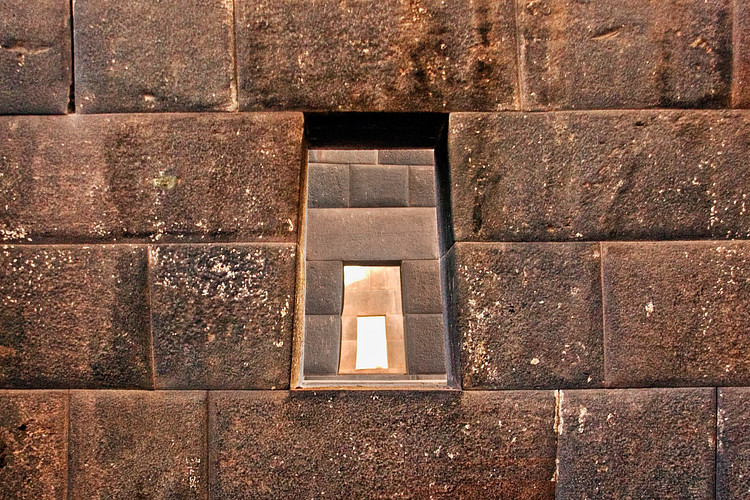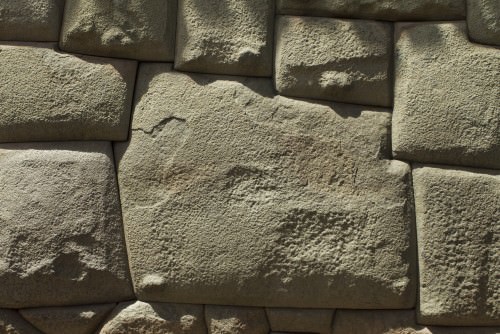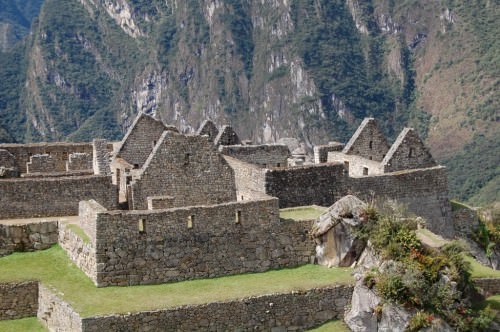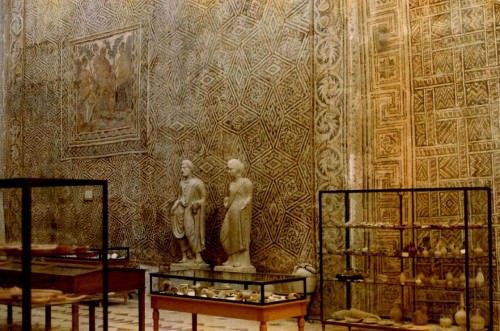Inca Architecture › The Heritage of Cuicul » Ancient origins
Articles and Definitions › Contents
- Inca Architecture › Ancient History
- The Heritage of Cuicul › Antique Origins
Ancient civilizations › Historical and archaeological sites
Inca Architecture › Ancient History
Definition and Origins

Inca architecture includes some of the most finely worked stone structures from any ancient civilization. Inca buildings were almost always practical and pleasing to the eye. They are also remarkably uniform in design with even grand imperial structures taking on a similar look to more humble buildings, the only significant differences being their much larger scale and quality of finish. Fond of duality in many other areas, another feature of Inca architecture is that it typically incorporated the natural landscape yet at the same time managed to dominate it to create an often spectacular blend of geometrical and natural forms.
MATERIALS
Stone was the material of choice and was finely worked to produce a precise arrangement of interlocking blocks in the finest buildings. The stone was of three types: Yucay limestone, green Sacsayhuaman diorite porphyry, and black andesite. Each block of stone could weigh many tons and they were quarried and shaped using nothing more than harder stones and bronze tools. Marks on the stone blocks indicate that they were mostly pounded into shape rather than cut. Blocks were moved using ropes, logs, poles, levers and ramps (tell-tale marks can still be seen on some blocks) and some stones still have nodes protruding from them or indentations which were used to help workers grip the stone. The fine cutting and setting of the blocks on site was so precise that mortar was not necessary. Finally, a finished surface was often provided using grinding stones and sand.
That rocks were roughly hewn in the quarries and then worked on again at the their final destination is clearly indicated by unfinished examples left at quarries and on various routes to building sites. The meticulous process of laying, removing, re-cutting and then re-laying blocks to make them fit exactly together was slow but experiments have demonstrated that it was much quicker than scholars had previously thought. Even so, it would have taken many months to produce a single wall.Interlocking blocks and sloping walls make Inca buildings extremely resistant, but not immune, to earthquake damage. 500 years of earthquakes have done remarkably little damage to Inca structures left in their complete state.
More humble structures used unworked field stones set with mud mortar or used bricks of dried mud (adobe) in areas with a drier climate. Both types of structure were typically covered in a layer of mud or clay plaster and then painted in bright colours.Walls at Puka Tampu, for example, still have traces of red, black, yellow and white paint.
Roofs were generally made of thatch from grasses or reeds placed on poles made of wood or cane. The poles were tied together using rope and fixed to the stone walls using stone pegs which protruded from them. These pegs could be fitted into the wall or be carved from one of the blocks, they could be circular or square, and they sometimes appear on interior walls to function as pegs, perhaps for textile wall coverings. Sometimes the top of the gable had a stone ring, again for attaching the roof. The incline of roofs was steeper in rainier parts of the empire, often 60 degrees.
TYPICAL FEATURES ARE FINE-CUT STONEWORK, TRAPEZOID SHAPES, AND PURPOSELY POSITIONED PORTALS.
FEATURES
The vast majority of Inca buildings were rectangular and most of these had a single entrance and were composed of only one room as dividing walls are not common in Inca design. There are some rare examples of multiple-doored long rectangular structures and even buildings which were circular or U-shaped but the norm was for straight-walled structures. Most buildings had only a single storey but there are some structures with two, especially those built into hillsides and the more impressive imperial structures at the capital Cuzco where sometimes there are examples of three-storey buildings.
Inca exterior walls commonly slope inwards as they rise (typically around 5 degrees), giving the building a distinctive trapezoid form. The trapeziod form is more common in the north and centre of the empire and one of its optical effects is to make walls seem higher and thicker than they actually are. The trapezoid motif was repeated in doorways, windows and interior wall niches. Doorways and windows often also have double jambs and the former are usually topped with a large single stone lintel.
Architecture in the capital and the imperial buildings dotted across the empire were remarkably similar in their design to other more mundane structures. They were, of course, often much larger in scale and the quality of their stonework was much higher. They could also be more ambitious in design by employing curved walls and they could be decorated more lavishly, for example, with gold sheeting as at the sacred Coricancha precinct at Cuzco whose curved wall section survives in part today.This duality of lower and higher class buildings being the same yet different was very much a trait of the Inca culture in general.

Inca 12 Angle Stone
Inca buildings may have been uniform in their basic design principles and may appear to lack individuality but the names of several architects have survived in the historical record - names like Huallpa Rimichi Inca, Inca Maricanchi, Acahuana, Sinchi Roca, and Calla Cunchuy - which suggests there was some individuality permissible in architectural design.
STRUCTURES
Rectangular buildings could be grouped in threes (or more) and arranged around an open but walled courtyard or patio, perhaps the most common Inca arrangement of buildings. This mini-complex is known as a kancha and functioned as administrative buildings, workshops, temples, accommodation or a mix of these. Very large buildings are known as a kallankaand these typically have several doors and face a large open space, often (once again) trapezoid in layout. They were probably used for public gatherings and as accommodation for representatives of the Inca administration and were clear public symbols of imperial control. Palaces were similar in design to smaller buildings just on a larger scale, with finer stonework and very often walled to restrict access and the viewing of royal personages.
Collca (or Qollqa ) were storehouses which were often built in groups or blocks. They could be round or rectangular but only had a single room. They are often situated on hillsides which gave them both good ventilation and shade, therefore, better preserving their perishable contents. Gravel under-flooring and drainage canals were additional aids in keeping the interior atmosphere dry and allowed for the storage of goods such as grain and potatoes for two years or more.

Kallanka, Machu Picchu
Inca settlements were rarely fortified as warfare was generally conducted via set-piece battles and the compliance of conquered peoples was ensured through political, economic and cultural means rather than military ones and imposing imperial architecture was an important part of the colonial process. However, there are exceptions. Some have seen Machu Picchu as a fortified site whilst last-stand settlements against the Spanish such as Ollantaytambo were fortified with large block terrace walls.
Hillside terracing, like buildings, used either loose rocks fixed with mud mortar or finely cut large blocks. They could extend the land available for cultivation and provide better water and drainage for crops but they were also sometimes merely decorative and planted with flowers. Those terraces at Pisac and Ollantaytambo are amongst the most impressive and their design has a definite and planned aesthetic effect.
Even rock outcrops were carved into functional forms by the Inca. For example, at Sacsayhuaman a throne-like carving with steps was cut into a stone hill. Sections of smaller rock outcrops could be cut into geometrical shapes or designs such as zig-zags and rectangles cut into the rock, their exact purpose unknown. Such works also purposely exploited the play of light and shadow to give a further geometrical dimension to the natural landscape. For example, the zig-zag walls at Sacsayhuaman create triangular shadows which seem to mirror the shadows created by the mountain peaks in the background. Rooms were also cut out of natural clefts in rock, one of the most famous being the temple shrine of the sun god Inti beneath the Torreón tower at Machu Picchu.

Machu Picchu
SETTING
Town planning was an important point of consideration for Inca architects. Main roads often cut through towns at an angle, Huánuco Pampa is a good example. Entire zones of a town were built in alignment with the central plaza and its ushnu and royal residences typically faced the sunrise. More generally, the long sides of Inca buildings were usually set parallel to plazas.Blocks of buildings were never quite square and were intersected by narrow straight roads built only for pedestrians.Sometimes even the entire town had a planned form of its own, the most famous example was the intention that the layout of Cuzco should create the figure of a puma when seen from above.
Another important consideration for Inca architects was the placing of buildings, doors and windows in such a way that views were seen to their best advantage and that astronomical bodies and events - certain stars or the sun during the solstices, for example - were visible through these portals. It is rare for the portals of an Inca building not to consider the environment in which they were constructed.
On another level, Inca architects also very often sought to harmoniously blend their structures into the surrounding landscape.Perhaps the most famous example of this is Machu Picchu, which follows the contours of the hillside and even incorporates natural features such as large rocks into the actual buildings. Sometimes the outline of a sacred stone or building was even designed to mimic the contours of a natural feature such as a distant mountain. Other celebrated examples of walls seamlessly incorporating underlying rocks are the hunting lodge of Tambo Machay and the sacred fortress site of Sacsayhuaman at Cuzco. The result of this integration is a somehow harmonious blend of the organic and the geometric and a clear message was given that just as rulers can dominate a subject people, so too humanity can respect, but ultimately dominate, nature.
The Heritage of Cuicul › Antique Origins
Ancient Civilizations
There are few places on earth where we can say that these stones, on which we are standing, are the same stones where feet rested centuries before.
These places are important. We walk in the Roman Forum, we explore the ruins of the Flavian Amphitheatre, and we journey to the pyramids of Cairo. These places are known and as such preserved from ancient times until today, preserved due to the proximity in or near large contemporary cities that protect and promote their unlimited value.
These places are important. We walk in the Roman Forum, we explore the ruins of the Flavian Amphitheatre, and we journey to the pyramids of Cairo. These places are known and as such preserved from ancient times until today, preserved due to the proximity in or near large contemporary cities that protect and promote their unlimited value.
Rome, Athens and Cairo retain a value that goes beyond the mere archaeological but they contain an interior jealously kept and hidden from normal view.
We are committed to normal digging and pulling out of the sand the testimony of a world preserved by chance, and we can also say that sometimes it helps to preserve the nature of what now under layers of soil, peat or under water, but natural selection is not only for living beings, it also applies to the material remains of the past. However, every kind of weather, and all kinds of land, can both preserve and destroy various materials, only leaving the merest crumbs to try to follow in order to reconstruct the world that was.
But where is humankind, where humans built? This is a factor that will win through every type of climate. It has given us as a society of storytellers that regale with these tales of the past long abandoned.
There are places on this earth that have been gradually abandoned and forgotten. Yet still they remain. Elements of life such as roads, houses and theatres, all remain perfectly still and waiting.
The example that strikes me most in my past is Djemila, in the mountains to the north of Algeria, in the province of Setif.

Cuicul Cardo Maximus
UNESCO registers it as a monument initially in 1982 as a site whose importance is of an example of a Roman town in a mountainous area. In 2009 their profile is updated with new levels of evaluation criteria, and as such, regaled with a higher importance. To understand why, we must consider the weight of the word "abandoned" or understand what makes this place unique. The city built under the Emperor Nerva remained thriving for 450 years. Yet it was hastily abandoned after the conquest of the Byzantines in 553 AD.
Nothing more of any real note happened in the history of Cuicul. Before UNESCO appeared, in 1909 it was touched by hands not felt in 1500 years.
It is amazing if you think that the modern city expands from Djemila just south of the abandoned city. Almost like an expansion, the new city is a neighborhood adjacent to the old one.
Since the 1980s when the city was taken charge of by UNESCO, there was a slow progress in the studies of the site. The references are almost non-existent. The museum began as a battered installation of mosaics. I wonder if this lack of modern studies can be attributed to the fact that there is nothing to explain, no academic debate, we have the dates, we have the inscriptions and we know perfectly well the intended use of every single public building. It is almost as if the lack of interpretative problems does not make it special.

Djemila Museum
It is in the glory of detail that this city comes to life.
Cuicul is an establishment of an ancient Roman colony founded during the reign of the Emperor Nerva in the late 1st century, (96 to 98 AD). The classic formula of Roman urban planning was adapted to the physical constraints of the site. At both ends of the 'Cardo Maximus' ('The Great Centre'), which is the very the backbone of the city, there are two gates.
In the 'Nucleus' (center) is the forum, an enclosed square surrounded by buildings essential to the function of civil and social life. The Capitol to the north, to the east the Curia, and the Civil Basilica (Basilica Julia) to the west.
Aristocratic dwellings set with rich mosaics from which they take contemporary Their names (the House of Amphitrite, the House of Europe, etc.) Multiplied during the course of the 2nd century is this central quarter, where the Temple of Venus, the Venus Genetrix (Mother) and the Macellum (covered market) are also located. However, this defensive position of the area resulted in a cramped city scape, hemmed in by walls, which hindered further development of the city.
The vestiges of the Temple of Venus and the aristocratic residences which are richly decorated with mosaics visible are also visible. Vestiges of monuments that have marked the expansion of the city (mid-2nd century) to the south also included is a new quarter, which is rich in both public and private buildings and dwellings.
Here was built the Arch of Caracalla, the temple of the family of Severus line of Imperial Dynasty. A new Forum was established in accordance with tradition; a theater with the capacity of 3000 seats was further developed (already completed under Antoninus Pius ). Further along, baths were constructed in the reign of Commodus. Among the buildings of the classical period the Basilica clothing (cloth market) and a fountain that is a small-scale replication of the Meta Sudans in Rome are worthy of note.

Cuicul Thermae
The site has also been marked by Christianity in the form of several cult buildings: a cathedral, and a church baptistery are considered among the biggest of the Paleo-christian period.
From site evaluation criteria of the UNESCO site:
Criterion (iii): Testimony to exceptional Djémila bears testimony to which civilization has disappeared. It is one of the world's most beautiful Roman ruins. The archaeological vestiges, the Roman integrated urban planning and the surrounding environment comprise the elements of what represent the values that are attributed to this site.Criteron (iv), is an outstanding example Djémila of a type of architectural ensemble illustrating a significant stage in the history of Roman North Africa, from the 2nd to the 6th centuries. In this instance, the classic formula of Roman urban planning has-been adapted to the geophysical constraints of the site. The site comprises of a diversified architectural and typological repertoire with a defensive system a Triumphal Arch, public conveniences and theater buildings and facilities for commerce and craft works. Also including the market of the brothers Cosinus that constitutes remarkable evidence of the city of economic prosperity.
There are places outside of normal reality, and we want these places to be accessible, although they are accessible to most of the opportunities, Djemila could become one of the most popular places in the world, a place for tourists, with a bookshop and café. Its amazing condition due to the fact that few people have visited from the abandoned Cuicul raises the question: how would an intensive development of this place work?
In this case, can we better preserve the site for posterity, better than anyone has done for 1500 years?
LICENSE:
Article based on information obtained from these sources:with permission from the Website Ancient History Encyclopedia
Content is available under License Creative Commons: Attribution-NonCommercial-ShareAlike 3.0 Unported. CC-BY-NC-SA License